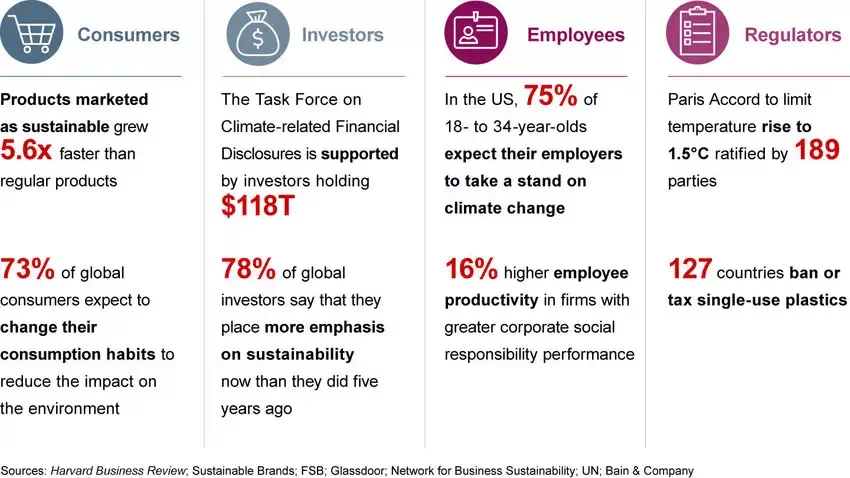Customer satisfaction has always depended on supply chains. Yet now they must do more than simply deliver the product that customers want, when they want it. Today’s supply chains must also deliver on a brand promise: sustainability. The World Economic Forum published the below article with examples from the automotive remanufacturing industry.
Across business-to-business and business-to-consumer industries, customers, investors, employees and regulators are demanding more sustainable products and production (see figure below). Bain & Company’s Elements of Value research shows that companies that successfully match customers’ sustainability expectations are rewarded with higher revenue growth and customer loyalty. As Ilham Kadri, CEO of chemicals provider Solvay, puts it: “sustainability is profitability.

The operational implication is that companies must be able to see everything in their supply chains, trace where it came from, and trace where it went: from the smallest raw material inputs to finished products. Increasingly across industries, true sustainability also means companies must know what happens to their products beyond the point of sale. That redefines—or at least stretches—the current mission for many leaders overseeing supply chain design and management. It also demonstrates why viewing products through the customer’s eyes can be an important guide to determining how supply chains must evolve.
The automobile industry offers one example. The surge in electric vehicle sales and car sharing demonstrates increasing interest among consumers in sustainable mobility solutions. But the rise of electric vehicles poses the challenge of how to make battery production and disposal more sustainable, a supply chain question at its core. Industry participants in the design, manufacture and distribution of batteries are working with legislators to develop circular supply chains that allow for the responsible sourcing, recycling, remanufacturing or reuse of electric vehicle batteries and their raw material components.
In order to scale-up efforts to reduce, reuse, recycle and remanufacture, stakeholders across entire supply chains must also scale the adoption of digital traceability tools. This will provide businesses with the many valuable capabilities, including the three following examples, to deliver the sustainable products and services customers expect.
1. Upstream visibility for sustainable inputs
Digital tracing technologies allow manufacturers and brands to shine a light on previously opaque supply networks. Their upstream suppliers play a critical role here, since they know the provenance of inputs and materials. But manufacturers need to strike a careful balance between the insights they need for sustainability and the need to protect their suppliers’ interests.
That means each industry needs to develop information sharing and system integration standards that allow efficient data sharing in a world where one supplier often serves multiple customers across different sectors. It also means incentivizing suppliers to improve their own product tracing, a potential challenge for a manufacturer if they are not one of their supplier’s major customers.
New technologies can help support these incentive mechanisms. For example, blockchain technology can house the provenance data for specific inputs, and do so with the required privacy, allowing customers to choose the product that best fits their buying criteria and sustainability standards, which in turn will lead to more demand and revenue for suppliers who meet those standards.
2. Downstream visibility to enable reverse logistics
Digitally tracing products after the point of sale—often referred to as a ‘digital thread’ that follows a product throughout its lifecycle—opens up opportunities for new service business models and allows manufacturers to proactively manage a product’s end of life through remanufacturing or recycling.
This is simpler and more common in B2B relationships where service contracts govern customer relationships and information sharing. On the consumer side, maintaining a digital thread while still protecting the privacy of end customers is a trickier task, but industry coalitions and partnerships with consumer organizations can help reduce risk and speed up these efforts.
3. Product authentication to promote reuse
Digital tracing technology can also help authenticate goods for resale, which has been relevant in industrial applications in the past, but is also particularly valuable in the rapidly growing secondary market for many consumer goods. Digital verification technologies increase consumer trust and extend the life of products, but can also align the interests of brands and secondary marketplaces that have historically had limited reasons to collaborate and share data.
As brands look to extend the life of their products and actively manage the consumer experience in secondary markets, certification that a product bears an authentic brand can help reduce the volume and value of counterfeits. That comes with a massive additional sustainability benefit: fake products often come from very opaque supply chains that likely violate many of the United Nation’s Sustainability Development Goals, particularly those focused on sustainable production and safe and decent conditions for workers.
Across industries, sustainability—and the supply chain traceability on which it depends—is the cost of entry for companies today. Traceability depends on companies figuring out how to collaborate within and across industries. This is the goal of the World Economic Forum’s Accelerating Digital Traceability for Sustainable Production initiative. All companies should be thinking now about how customer and other stakeholder needs may reshape their supply chains, and how they will partner across their industries for more sustainable products and a healthier, safer world.






